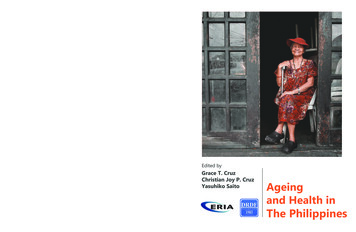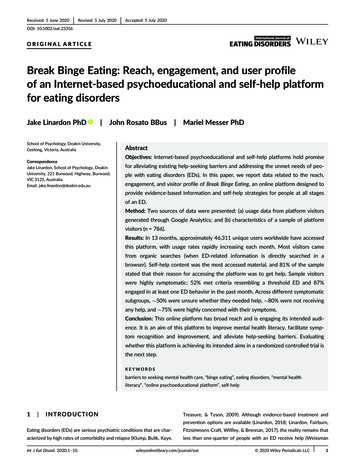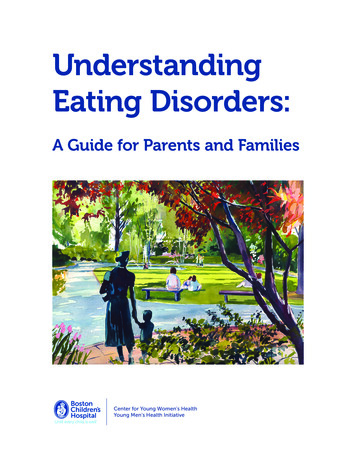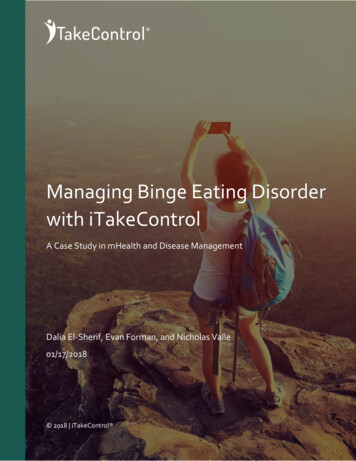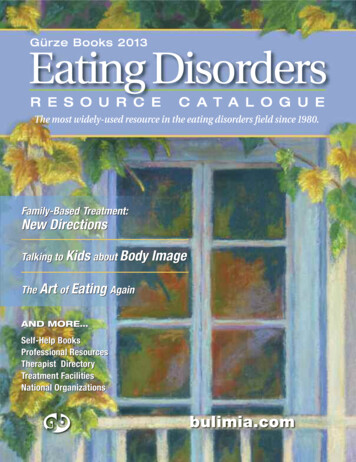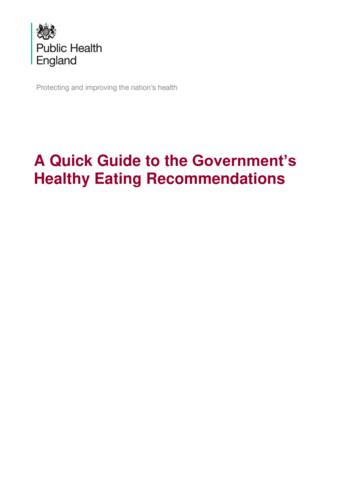
Transcription
HEALTHYEATING FORHEALTHYAGEINGNUTRITIONFOR VETERANS1/37PREVENT CONNECT ENHANCE
ACKNOWLEDGEMENTSThis manual was developed by Daniel So, as partial requirements for the Master of Nutrition and Dietetic Practice at BondUniversity under the supervision of Tara Diversi, APD (National Dietetic Advisor, DVA), Peta Patterson, APD (Bond University)and Dr Dianne Reidlinger, APD, RD (Bond University).We would like to acknowledge and thank the Australian Government Department of Veterans’ Affairs in particular JeffFairweather and Dimitri Batras for facilitating this project in and for providing feedback on the draft materials and assistancethroughout the project.Copyright Commonwealth of Australia 2016The Department of Veterans Affairs Healthy Eating for Healthy Ageing resource is released under the terms of the CreativeCommons licence accessed through the following link: https://creativecommons.org/licenses/by/4.0/ This allows you to usethe resource with acknowledgement, without payment, but only for non-commercial purposes and no adaptation or use inother works is permitted. Please read the Creative Commons Licence in full before downloading or otherwise making use ofthe ManualIf you do not agree to be bound by the Creative Commons Licence then you must not use this resource.When using the resource you must attribute The Department of Veterans Affairs and any identified author in accordancewith the terms of the Creative Commons Licence.For further information contact:Department of Veterans' AffairsGPO Box 9998Brisbane QLD 40011800 555 254Last Updated 3 April 2018Images: iStockP035672/37
PREFACEThis booklet is designed to provide general nutrition and healthy eating information toVeterans within the Department of Veteran’s Affairs (DVA) community. This resource isaligned with DVA’s ‘Social Health Strategy 2015 – 2023 for the Veteran and Ex-serviceCommunity’. The booklet complements social health initiatives such as the Cooking forOne or Two program.VisionImproved quality of life for the veteran and ex-servicecommunity, achieved through preventing illness wherepossible, fostering social connectedness and enhancing healthand wellbeing.About DVA’s ‘Health and Wellbeing’ activitiesThe Department of Veterans’ Affairs (DVA) provides support to current and formerserving members and their families and carers through a range of services and paymentsThese services are designed to assist you to manage your health and lifestyle andsupport those you care for.For more information, visit http://www.dva.gov.au/health-and-wellbeing or call1800 555 254.3/37
INTRODUCTIONAs you get older, eating healthily can be a challenge. Maintaining good eatinghabits can become more difficult as bodies and therefore requirements change.Changes to your body’s kilojoule (Calorie) and nutrient needs, sense of taste andsmell, dentition (teeth) and changes to your ability to access and prepare food canbe a normal part of getting older. These factors, whether they appear bythemselves or in combination, can make staying nourished trickier than it mayseem. Small changes to what or how you eat may result in big returns in terms ofyour health.This booklet aims to act as a practical guide to help you understand and navigatethrough some of the barriers to healthy eating associated with ageing. It containsinformation about: How to achieve a healthy and nourishing diet.How different food groups come together as part of a healthy diet.How a healthy diet can contribute to health and wellbeing.The role of ‘extras’ in your diet and vitamin supplements.Dealing with some of ageing’s effects on nutrition.Hydration.Tips to get more out of shopping and cooking.A sample meal plan.For additional information or personalised nutrition care plans, please discuss withyour General Practitioner to be referred to an Accredited Practicing Dietitian.4/37
DIETARY GUIDANCEThis information, based on the Australian Dietary Guidelines(www.eatforhealth.gov.au), shows the 5 core food groups and the number oftheir servings you should aim for every day to maintain your health. The goalof these recommendations is to achieve a healthy and nourishing diet –providing enough energy and nutrients to meet your requirements2.It’s important to note that these guidelines apply to all healthy Australiansand those with common health conditions such as being overweight.However, they may not be appropriate to those living with medicalconditions that require more specific dietary requirements. If this is you,please consult an Accredited Practicing Dietitian for advice.5/37
What does a healthy diet mean for you?Following these recommendations and making healthy food choicespromotes health and wellbeing, with benefits such as: Feeling better, mentally and physically. Having more energy for daily activities. Being more resistance to infection. A reduced risk of developing certain health conditions. Maintaining a healthy weight. Improved quality of life1, 2.6/37
How much do I need each day?MenWomen51 - 7070 51 - 7070 Grain (cereal) foods64½43Vegetables5½555Fruit2222Lean meats andpoultry, fish, eggs,tofu, nuts & seeds, andlegumes/beans2½2½22Milk, yoghurt, cheeseand/or alternatives2½3½44Dietary Recommendations for Older Adults (adapted from the Australian Dietary Guidelines)2.7/37
Another way to look at these recommendations is the Australian Guide toHealth Eating plate 3 below. It helps visualise the proportion of food fromeach food group that you should aim for each day.Table adapted from the Australian Guide to Healthy Eating3.8/37
What is a serve of grain* (cereal) food?A standard serve is (500kJ) or:1 slice (40g)½ medium (40g)½ cup (75 - 120g)½ cup (120g)⅔ cup (30g)¼ cup (30g)3 (35g)1 (60g)1 small (35g)breadroll or flat breadcooked rice, pasta, noodles, barley, buckwheat,semolina, polenta, bulgur or quinoacooked porridgewheat cereal flakesmueslicrispbreadscrumpetEnglish muffin or scone*Grain (cereal foods), mostly wholegrain and/or high cereal fibre varietiesTable adapted from the Australian Dietary Guidelines2.What is a serve of vegetables?A standard serve is about 75g (100-350kJ) or:½ cup½ cup1 cup½ cup½ medium1 mediumcooked green or orange vegetables (e.g. broccoli, spinach,carrots or pumpkincooked, dried or canned beans, peas or lentils (preferablywith no added salt)green leafy or raw salad vegetablessweet cornpotato or other starchy vegetables (sweet potato, taro orcassava)tomatoTable adapted from the Australian Dietary Guidelines2.9/37
What is a serve of fruit?A standard serve is about 150g (350kJ) or:1 medium2 small1 cupapple, banana, orange or pearapricots, kiwi fruits or plumsdiced or canned fruit (no added sugar)Or only occasionally:125 ml (½cup)30gfruit juice (no added sugar)dried fruit (e.g. 4 dried apricot halves, 1½ tablespoons ofsultanas)Table adapted from the Australian Dietary Guidelines2.10/37
How much is a serve of lean meat and poultry, fish,eggs, nuts and seeds, and legumes/beans?A standard serve is (500-600kJ):65gcooked lean red meats such as beef, lamb, veal, pork, goator kangaroo (about 90-100g raw)80gcooked lean poultry such as chicken or turkey (100g raw)100gcooked fish fillet (about 115g raw) or one small can or fish2 large (120g)1 cup (150g)170g30geggscooked or canned legumes/beans such as lentils, chickpeas or split peas (preferably with no added salt)tofunuts, seeds, peanut or almond butter or tahini or othernut or seed paste (no added salt)**Only to be used occasionally as a substitute for other foods in the group. These foodsprovide similar amounts of energy to the other foods in the group, but contains lessnutrientsTable adapted from the Australian Dietary Guidelines2.11/37
How much is a serve of milk, yoghurt, cheese and/oralternatives?1 cup (250ml)½ cup (125ml)fresh, UHT long life, reconstituted powdered milk orbuttermilkevaporated milk2 slices (40g)or 4 x 3 x 2cm cube (40g) of hard cheese, such as cheddar½ cup (120g)¾ cup (200g)ricotta cheeseyoghurtsoy, rice or other cereal drink with at least 100mg ofabsorbed calcium per 100ml1 cup (250ml)If you do not eat any of the foods from this group, the following foods contain about thesame amount of calcium as a serve of milk, yoghurt or cheese (they contain about thesame amount of calcium, but may provide more energy)100g60g½ cup (100g)100galmonds with skinsardines, canned in watercanned pink salmon with bonesfirm tofu (calcium levels may vary so check the label)Table adapted from the Australian Dietary Guidelines2.12/37
EXTRASSome foods fall outside these core food groups. These foods are separatedinto unsaturated spreads and oils, and discretionary choices2.Unsaturated spreads & oilsUnsaturated spreads and oils, such as margarine spreads and olive oilscontain unsaturated fats and are high in energy. They can also add flavoursto foods, contain essential vitamins, and have a number of positive effectson health2.If you have been advised to gain weight, added unsaturated fats can be veryuseful. Due to their high energy content, using a little can boost the energy(KJ) content of your food without making you feel too full.You can add olive oil on salad or vegetables, use a thicker spread on yourbread or top your meats with avocado.13/37
Discretionary choices‘Discretionary choices’ or ‘extra choices’ are the other foods that fall outsidethe recommendations. These foods include: Most sweet biscuits. Cakes. Desserts and pastries. Processed meats and sausages. Ice-cream and other ice confections. Chocolate and confectionary. Savoury pies and pastries. Commercial burgers and fried foods. Potato chips, crisps and other fatty and/or salty snack foods. Cream, butter and animal-based spreads. Sugar-sweetened beverages. Alcoholic drinks2.14/37
Discretionary food choices are high in energy, saturated fat, added sugarsand/or salt or alcohol2. Because these foods contribute to the enjoyment ofeating they can be included as part of a healthy diet in moderation.For general health, a maximum of two serves of these discretionary choicesis recommended per day2. These serving sizes are smaller than you’d expect– and a guide is provided on the next page.If you are watching your weight or have health conditions like heart diseaseor diabetes, one of the first stages to losing weight is reducing the number ofdiscretionary serves you eat per day.If you have been advised to gain weight, it may be beneficial toinclude more servings of discretionary choices in your diet.A little goes a long way in terms of the energy these foodprovide, and if you are struggling to maintain your weight, theymay be recommended for your health.15/37
What is a serve of discretionary food choices?A standard serve is discretionary choices provides about 500600 kJ2 scoops (75g)2 slices (50-60g)1½ thick or 2 thin(50-70g)½ snack-sizepacket (30g)2-3 (35g)1 (40g)1 slice (40g)5-6 (40g)1 tablespoon (20g)½ bar (25g)2 tablespoons (40g)1 tablespoon (20g)1 can (375ml)¼ pie or pastie(60g)12 (60g)200ml60ml600ml400mlice-creamprocessed meats, salami or mettwurstregular sausagessalty crackers or crispssweet plain biscuitsdonutplain cake/small cake-type muffinsugar confectionary/small lolliesjam or honeychocolatecreambuttersoft drinkcommercial meal pie or pastie (individual size)fried hot chipswine (2 standard drinks; but note this is often 1glass for many Australian wines)spirits (2 standard drinks)light beer (1½ standard drinks)standard beer (1½ standard drinks)Table adapted from the Australian Dietary Guidelines 2.Think of discretionary foods as the ‘cherry on top’ of your normaldiet – they’re a little extra you have on top of your normal diet,but shouldn’t be replacing the healthy food choices.While they are a nice treat to have, it’s important to eat therecommendations from the 5 core food groups so you are stillgetting the nutrients you need.16/37
KEY NUTRIENTSYou may wonder what these recommendations are based on?Foods from each food group are important and recommended in theseamounts because they are help us meet our need for quality nutrients.Foods from each food group (and even inside each group) bring differentnutrients to your diet. Nutrients are very different – some are needed inlarger amounts than others, and each have their own specific role to play inthe body. As outlined earlier, even though the amount of kilojoules you needmay have decreased, your nutrient requirements have not – so it’simportant to make every mouthful as nutritious as possible.The following table is a look at the nutrients most relevant to ageing.17/37
Nutrient Important forProteinCalciumVitamin DExamplesMaintaining musclestructure andstrengthBest sources include leanmeat, fish, poultry, eggs andmilk products. Wholegrains,beans/legumes and nuts &seeds are also good sources.Maintaining strongbones, preventingosteoporosis,reducing the risk offracturesBest sources are milkproducts (milk, yoghurt,cheese and calcium-fortifiednon-dairy drinks such as soymilk). Alternatives includetinned sardines and salmon,almonds and firm tofu.Maintaining strongbonesMaintaining strongbones and heartMagnesium function, as well asboosting immunefunctionPotassiumFood SourcesReducing bloodpressure andmaintaining strongbonesSunlight is a good source ofvitamin D. Oily fish (e.g.salmon & tuna), eggs andVitamin D-fortified foodssuch as margarines andmilks are other goodsources. Organ meats arealso an excellent source.Best sources are dark greenleafy vegetables,beans/legumes, nuts &seeds, fish and wholegrains.Other sources include milkcheese and yoghurt. Organmeats are also an excellentsource.Fresh fruits and vegetablewith minimal processing arethe best sources (especiallybananas and potatoes).Other good sources includenuts & seeds,beans/legumes,wholegrains, milk andyoghurt, and lean meats.18/37
Nutrient Important forZincBoosting immunesystemVitaminB12Maintaining healthynerve function andpreventing anaemiaFolatePreventing anaemiaFibreOmega-3OilsMaintaining healthybowel function,preventingconstipation andreducing cholesterollevelsReducing risk ofheart disease,dementia andmaculardegeneration, canalso improverheumatoid arthritissymptomsFood SourcesExamplesBest sources are seafood,meat, seeds andbeans/legumes. Othersources include milk,yoghurt, and wholegrains.Vitamin B12 is only found inanimal products (e.g. leanmeat, fish, poultry, eggs andmilk) and fortified soyproducts (e.g. soy milk).Best sources include darkgreen leafy vegetables, driedbeans/legumes, and fortifiedbreads and cereals. Othersources include avocado andpeanuts. Organ meats arealso an excellent source.Best sources of fibre arewholegrain breads & cereals,vegetables, beans/legumes,fruits, nuts & seedsBest sources are oily fish(e.g. salmon, sardines,mackerel and tuna). Otherplant-based sources includecanola oil, flaxseed/linseedoil, chia seeds, walnuts andsoybeansTable adapted from NDSS “Healthy Eating for Older People” 8.19/37
SAMPLE MENU PLANBreakfastBoiled or poachedeggs on wholegraintoastMid-morningsnackCrackers withcheese and tomatoslices, and a smallbananaMain mealMeat, chicken orfish, assortedvegetables andmashed potatoAfternoon snackA glass of milk &piece of fruitLight mealBaked beans ontoast, with a smallgarden saladSupperTub ofunsweetenedyoghurt and someberries20/37
AGEING & NUTRITIONAgeing can have a range of effects that can change how and what you eat.Managing your changing needsYour kilojoule and nutrient requirements can change as you age2.Your kilojoule needs are based on many factors, including your age,gender, weight, height, muscle tone, current health status, activity levelsand medical conditions.When you are less active, your kilojoule requirements decrease. On theother hand, some health and/or medical issues increase your kilojouleneeds. Just because you are not doing as much, your health condition maymean that you need to eat more than needed previously.A simple way to check if the amount of food you’re eating suits yourrequirements is to check your weight regularly. Losing weight is not alwaysa normal part of ageing, and you may need to review your food intake.Regardless of your energy needs, nutrient requirements do not decrease.In fact, some nutrients are needed in even greater quantities as we getolder2.21/37
The key to managing these requirements is to eat a varied and wellbalanced diet, and then tweak the amount of food based on your kilojouleneeds.You can control the types of nutrients we get from food by choosing whattype and quality of food you eat. Certain foods are more nutritious than others.For example, a juicy steak from the meat and alternatives food group is healthierthan a meat pie from the discretionary food group. Different foods have different nutrients, so a diet that is varied willprovide a more comprehensive nutrient coverage.For example, milk is rich in calcium but low in fibre, while wholegrain breads arehigh in fibre but low in calcium – eating both foods will ensure you receive bothnutrients.You have control over how many kilojoules you get by managing thequantity of food we eat. You can maintain our weight if the amount of food we’re eating issimilar to the amount our body needs Too little will lead to weight loss, and too much will contribute toweight gain22/37
Maintaining our weight is the ideal result – consistent weightloss can lead to malnutrition, which can not only reducequality of life, but open the door to a whole range of ailmentsand reduce your quality of life.Malnutrition affects older Australians at a rate estimated tobe between 10% and 60%4, 5, 6. Negative outcomes associatedwith malnutrition include: Impaired immune function, leading to increased riskinfections and delayed recovery Increased risk of osteoporosis, falls and fractures Poor wound healing Possible institutionalisation Reduced mobility 4You may have noticed that boxes such as these appearthroughout the booklet. These are designed to providegeneral tips on maintaining weight and avoiding malnutrition.If you and concerned about your nutrition or someone inyour family, for personalised care or advice, obtain a referralto consult an Accredited Practicing Dietitian.23/37
Changes to taste & smellYou may experience some changes in taste or smell as you get older. Thesechanges may be associated with your health problems, the medications youtake, or be simply due to the deterioration of the senses. To compensate forthis, you may choose to add additional flavour enhancers to experience thesame tastes you are used to. If you have certain health conditions (such askidney disease or heart disease), it is best to use options other than salt toflavour your meals, as too much salt can have negative effects on bloodpressure and the body’s water balance.We recommend using citrus (lemon or lime), herbs andspices such as pepper, garlic, ginger, turmeric, paprika,fresh leaf herbs to bring out flavours – their wide rangewill allow you to customise a variety of flavours!24/37
A guide to matching foods with flavoursFoodMatching herbs & spicesBeefBay leaf, marjoram, nutmeg, onion, pepper, sage or thymeLambCurry powder, garlic, rosemary or mintPorkGarlic, onion, sage, pepper or oreganoChickenGinger, marjoram, oregano, paprika, poultry seasoning, rosemary,sage, tarragon or thymeFishCurry powder, dill, dry mustard, marjoram, paprika or pepperCarrotsCinnamon, cloves, dill, ginger, marjoram, nutmeg, rosemary or sageCornCumin, curry powder, onion, paprika or parsleyGreen BeansDill, curry powder, marjoram, oregano, tarragon or thymeGreensOnion or pepperPotatoesDill, garlic, onion, paprika, parsley or sagePumpkinsCloves, curry powder, marjoram, nutmeg, rosemary or sageTomatoesBasil, bay leaf, dill, marjoram, onion, oregano, parsley or pepperCucumberschives, dill, garlic or vinegarPeasgreen pepper, mint, fresh mushrooms, onion or parsleyRicechives, green pepper, onion, paprika or parsleyTable adapted from North Carolina State University’s “Cooking with Herbs and Spices” guide 7.25/37
Difficulty chewingIf you have noticed changes to your ability to chew or swallow, it is importantto that you make an appointment with your GP for a referral to a CertifiedPractising Speech Pathologist.Difficulty with chewing can become problematic with age. Changes todentition can occur due to ill-fitting dentures or problems with your naturalteeth, and can make chewing certain foods such as nuts, fruits, meats andcrackers harder than it used to be.Ways to work around this include opting for softer varieties of these foods, orchanging ways you prepare these foods so that their texture is moreamenable to your dentition. You can get more information from anAccredited Practising Dietitian or Certified Practising Speech Pathologist.Soft foods Are described as naturally soft,or processed (cooked or cut)until soft These foods can be chewed butnot necessarily bitten, and canStewed fruit is a great alternative tohard fruit if you are finding it harderto chew.be easily broken up with a fork Ideally, these foods should bemoist, or serve d with a sauceor gravy to increase itsmoisture1026/37
Soft Foods ExamplesSoft VarietyAlternative toSoft sandwiches with veryDry or crust breads, bread withmoist fillings (e.g. egg andhard seeds or grainsmayonnaise)Breads & CerealsBreakfast cereals soaked Cereals with nuts, seeds and driedin milkfruitSoft canned vegetables(e.g. peas)VegetablesFruitsMeat &AlternativeHard, stringy or fibrous vegetables(e.g. broccoli stalks)Well cooked vegetables,served in small pieces, orsoft enough to bemashed/broken with aforkFresh, naturally soft fruitLarge/round fruit pieces(e.g. ripe bananas)Stewed and canned fruitsDried fruit, seeds and fruit peelin small piecesFruit juiceCasseroles with smallDry, tough, chewy or crispy meatstender pieces of meatMoist fishMeats with gristleWell cookedbeans/legumes, so thatHard or fibrous beans/legumesthe outer shell is soft (e.g.baked beans)Eggs (all types exceptFried eggsfriedSoft tofuYoghurtsDairySoft cheeses (e.g. ricottaor Camembert)Table adapted from the Australian Standardised Labels and Definitions of Texture-Modified Foods & Thickened Fluids10.27/37
Appetite changesChanges to appetite can have a big impact on your eating habits. A person’sappetite is likely to decrease with age. Smaller appetites can restrict theamount of food eaten, which can lead to missing out on important nutrients.One way to work around smallerappetites is to reduce the size ofyour meals and by eating morefrequently.Choosing more nutritious foodand snack options can helpmaximise the amount ofnutrients you get at each meal.The humble glass of milk is anexcellent snack option!These examples are packed with nutrients, as well as kilojoules:Avocado on crackers: great source of unsaturated fats and folateCheese & crackers: high in calcium and proteinBaked Beans: good source of protein, potassium, zinc and fibreYoghurt: great source of protein, calcium, magnesium and zincCustard: good source of calciumNuts: a good source of protein, magnesium, potassium and fibreEggs: good source of protein, B12 and Vitamin D28/37
VITAMIN SUPPLEMENTSVitamins and minerals are essential for your body to stay healthy. A varieddiet which follows the Australian Dietary Guideline recommendations willgenerally provide enough nutrients for healthy older Australians2. A generallower dose multivitamin may provide a benefit to people whose diets arerestricted (i.e. on a special or medical diet) or lacking in variety. However,taking vitamin and/or mineral supplements in lieu of eating a varied andnutritious diet is not recommended.Vitamins and minerals are best obtainedfrom food. Food, especially minimallyprocessed whole foods, contain a vastarray of nutrients and components thatwork together. Substituting food forsupplements is not a good idea as ageneral rule. For some people with certainmedical conditions or higher requirements,a supplement may be necessary.Vitamin supplements (as well as herbal supplements) can also interfere withcertain medications. Because of these potential side-effects, you shouldalways tell your GP what you are taking.29/37
HYDRATIONWater is essential for good health, but how much of it do you need?Fluid requirements are highly individualised. Although dietary guidelinesrecommend around 8 cups for women and 10 cups for men2, it’s a roughguide. How much water you actually need changes based on how active youare, muscle tone, age and health status.Ageing can potentially dull your sense of thirst9, so drinking to thirst is nolonger the best option as you get older. The best way for you manage yourhydration is to check and troubleshoot it yourself – it’s simpler than it sounds,and a guide is provided on the next page.Hydration is important no matter the weather, even during the cooler wintermonths when thirst isn’t as obvious.All fluids contribute to your daily intake –including teas, coffees, soups, milks andsugary drinks. However, when it comes tohydration, water is almost always thebest choice – it replaces the fluids youlose without adding any extras.If you have been advised to gainweight, hydrating with soups, milksand sugary drinks can help you geta more energy throughout the day.30/37
Checking your hydrationA simple way for you to check and troubleshoot your hydration is to checkyour urine colour.Clear to pale yellowIndicates you are well hydratedTransparent to light yellowIs normal, and indicates idealhydration statusPale honey, slightly transparentIndicates normal hydration, butyou may need to rehydrate soonSlightly cloudy yellowIndicates your body needs morewaterDarker yellow or amberNot a healthy colour – your bodyneeds more waterOrange-ish yellow and darkerIndicates severe dehydration –contacting your GP is advised31/37
SHOPPINGThese shopping tips may help turn your next grocery trip into a more efficientand nutritious journey! Creating a shopping list and pre-planning your meals for the week canlead to a more efficient shopping experience, and reduce the likelihoodof missing key ingredients. Shopping with a friend or relative can turn it into a social event, andhelp with issues. Consider participating in a guided supermarket tour They can provide valuable information to help you turn yourshopping experience into a more productive and nutritious one;giving you the confidence to make good food choices If supermarket accessibility or transport is a worry, check if your localstore offers home delivery services. Bulk-buying and storing freezable (i.e. bread or meat) and nonperishable foods (i.e. tinned varieties) can create a stockpile at home,giving you a readily available supply if you get sick or if you have troubleaccessing food stores. Shop online to make sure you buy everything you need. This can alsomake it easy to have someone else pick it up for you.32/37
COOKINGYou may find these hints helpful in preparing tasty and nourishing meals. Keep cooking straightforward. Simple and nutritious doesn’t need to becomplicated or time-consuming. If you’re not confident with cooking: Check with your local Ex-Service Organisation to see if they areoffering a Cooking for One or Two program Opt for simple meal tactics such as a ‘meat and three-veg’approach, serving ready-made meat products with boiled ormashed potatoes and steamed or boiled vegetables (e.g. carrotsor broccoli). Ask a friend or relative for cooking advice, or turn it into groupactivity and prepare meals to share. Cook in a big batch and separate them in single portions, leaving themavailable for another time. See light snacks as opportunities to have a nutritious light meal, such asopting for baked beans, a yoghurt, or soup with wholegrain toast.33/37
Cooking for One or TwoThis program is a DVA initiative designed for veterans to improve cookingskills, discuss nutrition and engage socially. It’s a group program, where overfive sessions, the group cooks a delicious, easy, quick and nourishing twocourse meal, including a main and dessert, before enjoying the meal together.The program is not just a cooking demonstration, but provides an opportunityfor participants to develop their cooking skills in a supportive environment. For more information about the program, and details on how tosign up, visit the “Cooking for 1 or 2” website althpublications/cooking-one-or-two-programme If you need assistance with shopping and/or cooking, call 1800 200 422or go to the My Aged Care website at: www.myagedcare.gov.au. If you are not confident, or have difficult cooking, consider contactingmeal delivery services such as Meals on Wheels: Meals from Meals on Wheels are designed to be eaten in a singlesitting. Try not to split the meals (i.e. half at lunch and half atdinner), as this may not provide all the nutrition you need.34/37
DIRECTORYDietitians Association of Australia (DAA): www.daa.asn.au 1800 812 942DVA Cooking for 1 & 2: ations/cooking-one-or-two-programmeDVA Health and Wellbeing: www.dva.gov.au/health-and-wellbeingDVA: www.dva.gov.au/Eat for Health (Australian Dietary Guidelines): www.eatforhealth.gov.au/Meals on Wheels (National Directory): www.mealsonwheels.org.au/find-us/My Aged Care: www.myagedcare.gov.auQueensland Meals on Wheels: www.qmow.org/ 1300 90 97 9035/37
REFERENCES1. National Health and Medical Research Council. (2013). Eat for Health Educator Guide Information fornutrition educators. Retrieved 04/04/2016 /files/files/the guidelines/n55b educator guide 140321.pdf2. National Health and Medical Research Council. (2013). Eat for Health Australian Dietary Guidelines Summary.Retrieved 04/04/2016 /files/files/the guidelines/n55a australian dietary guidelinessummary 131014.pdf3. National Health and Medical Research Cou
How different food groups come together as part of a healthy diet. How a healthy diet can contribute to health and wellbeing. The role of extras in your diet and vitamin supplements. Dealing with some of ageings effects on nutrition. Hydration. Tips to get more out of s
